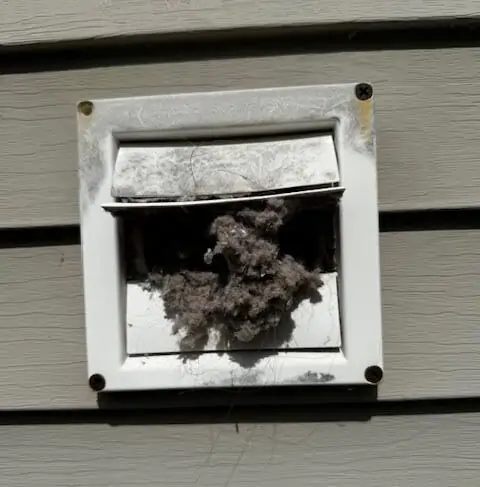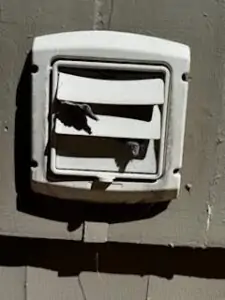Why and how to detect a clogged dryer vent. If your dryer takes too long than usual to dry one load or the laundry room feels unusually warm, dusty and humid, it could be a sign of a clogged dryer vent. Clogged vent isn’t just an inconvenience; it’s a serious issue of safety, and the indoor air quality in your home or business.
Why a Clogged Dryer Vent Is a Big Deal
A dryer vent’s job is to blow hot, moist air from your dryer to the outside of your living space and business. Moisture, , lint, dust from clothes could build up inside the vent system. When that buildup becomes excessive, airflow is restricted and then clogged.
This situation can lead to:
- Dryer Fire. Lint is extremely flammable.
- Poor dryer efficiency A clogged vent forces your dryer to run longer,
- Poor indoor air quality – Blocked vents can push dust, lint to the living space.
- Mold issue. Moisture can start a mold groth.
Clogged dryer vent is not about your laundry, it about your safety and health.
How to Detect a Clogged Dryer Vent
Detecting a clogged dryer vent early prevents costly repairs
1. Extended drying cycle. Clothes Take Longer to Dry. One of the first warning signs of a clogged vent is longer drying times. Check the dryer vent if your dryer cycle that once took 40 minutes now takes 60 or more. .
2. The Dryer Feels Too Hot to Touch. It is red flag If the exterior of your dryer or the laundry room feels unusually warm after or during the drying cycle.
3. Burning Smell coming from the Dryer. A burning or musty odor while the dryer is running can be a sign of clogged dryer vent.
4. Lint Buildup around the Vent Opening. Check the vent exhaust flap outside your home or business. To see If you see lint buildup around the vent cover or notice the flap doesn’t open.
5. Excessive Lint in Laundry room and clothes. After drying, if your clothes are covered in lint or feel damp, the vent might not be allowing air to escape properly. This is another sign the airflow is restricted.
6. Poor Airflow from the Exterior Vent. No Air flow from exterior vet. During operation, place your hand near the outdoor vent. You should feel a steady, strong, warm flow.
7. The Dryer Shuts Off Unexpectedly Modern dryers have built-in safety features that cause them to shut down and show error message as D90 or D75 when dryer vent is clogged.
Is There a Link Between Clogged Dryer Vents and Indoor Air Quality?
You might not immediately associate dryer vent maintenance with the air you breathe but the two are closely connected. Here’s how a clogged vent can negatively impact indoor air quality in homes and businesses:
1. Increased Dust and Allergens
When lint and debris back up into the dryer and laundry area, they can circulate throughout the building via HVAC systems or natural airflow. This adds extra dust and allergen particles to the air, worsening allergy and asthma symptoms.
2. Moisture and Mold Growth
Blocked vents trap humid air inside the dryer and ductwork. This moisture can seep into walls or ceilings, creating an ideal environment for mold and mildew. Mold spores can spread through the air, causing health problems such as coughing, eye irritation, or sinus infections.
3. Carbon Monoxide Buildup (for Gas Dryers)
If you have a gas dryer, a clogged vent can trap exhaust gases including carbon monoxide inside the home. This is extremely dangerous and potentially life-threatening. Proper venting is essential to allow toxic fumes to escape safely.
4. Odors and Stale Air
Lint and moisture buildup can create unpleasant odors that linger in your laundry area and circulate throughout your space. Cleaning the vent restores fresh airflow and helps eliminate stale smells.
How Regular Dryer Vent Cleaning Improves Air Quality
Routine maintenance of your dryer vent isn’t just about keeping your appliance efficient it’s about creating a cleaner, healthier indoor environment. Here’s how professional dryer vent cleaning makes a difference:
1. Removes Built-Up Lint and Contaminants
2. Reduces Moisture and Mold Risks
3. Prevents Odors and Improves Freshness
4. Supports a Healthier Environment for Employees and Customers
DIY Dryer Vent Inspection Tips
While professional dryer vent cleaning is always recommended at least once a year, there are simple inspections you can do on your own to monitor vent health.
- Check the lint trap after every load. Clean it thoroughly to prevent buildup from entering the vent.
- Inspect the exterior vent hood regularly to ensure it’s clear of lint, nests, or debris.
- Use a flashlight to look inside the duct from both ends. If you see significant lint buildup, schedule a cleaning.
- Avoid long, flexible plastic ducts—they trap lint easily. Rigid or semi-rigid metal ducts are safer and more efficient.
- Listen for changes in dryer sound or performance. A louder, hotter, or longer-running dryer may indicate restricted airflow.
When to Call a Professional Dryer Vent Cleaning Service
Some light cleaning tasks can be done yourself, but professional technicians use high-powered tools, vacuums, and rotary brushes to thoroughly remove lint and blockages deep inside the vent line.
You should call a certified dryer vent cleaning company if:
- Your dryer hasn’t been serviced in over 12 months.
- You notice any of the signs listed above (long drying times, hot dryer surface, burning smells, etc.).
- You operate a commercial laundry system or multiple dryers in one building.
- You suspect animal nests or major obstructions inside the duct.
Professional cleaning typically takes less than an hour and immediately improves dryer performance and air quality.
How Often Should You Clean Your Dryer Vent?
- Homes: At least once per year for single-family homes, or more often if you have pets or large laundry loads.
- Apartments and condos: Every 6–12 months, depending on dryer use and vent length.
- Businesses: For commercial dryers, hotels, and salons, quarterly or semi-annual cleaning is often necessary due to heavy usage.
Preventing Future Dryer Vent Clogs
Once your dryer vent is clean, follow these steps to keep it that way:
- Clean the lint screen before every load.
- Avoid overloading the dryer. Too many clothes restrict airflow and cause lint buildup.
- Use shorter, straighter vent runs to reduce lint accumulation.
- Check behind the dryer regularly to ensure the vent hose is not crushed or disconnected.
- Install a lint alert system to notify you when airflow becomes restricted.
Finaly
Detecting and addressing a clogged dryer vent isn’t just about convenience—it’s about safety, energy efficiency, and the air you breathe. From identifying warning signs like long drying times and hot dryers to understanding the connection between vent blockages and indoor air pollution, you can take proactive steps to protect your home or business.
Regular dryer vent cleaning helps eliminate lint buildup, prevents fires, and enhances indoor air quality. Whether you manage a busy commercial facility or a single-family home, keeping your dryer vent clean ensures your system runs efficiently and your air stays fresh, healthy, and safe.
FAQ
1. How can I tell if my dryer vent is clogged?
Common signs of a clogged dryer vent include longer drying times, clothes that feel hot but still damp, a burning smell while the dryer is running, and lint buildup around the vent opening.
2. Can a clogged dryer vent affect indoor air quality?
Yes. When your dryer vent is blocked, dust, lint, and moisture can circulate back into your home or business.
3. How often should I have my dryer vent cleaned?
For most homes, dryer vents should be professionally cleaned once every 12 months. However, larger households or commercial facilities (laundromats or salons) should schedule cleaning every 3 to 6 months, depending on usage..
4. Is it safe to clean my dryer vent myself?
You can perform light maintenance, like cleaning the lint trap after each use and checking the vent hood outside..
5. What are the benefits of professional dryer vent cleaning?
Professional dryer vent cleaning helps prevent dryer fires, reduces drying times, lowers energy bills, and improves indoor air quality. er.




